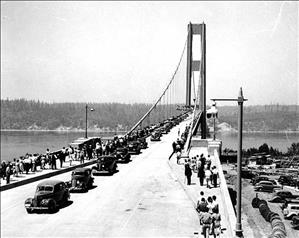On July 1, 1940, the Tacoma Narrows Bridge is dedicated and opens to traffic. It is a clear day with blue skies, and some 10,000 people turn out for the occasion. The bridge, which connects Tacoma to the Kitsap Peninsula, promises to stimulate the economy of Tacoma. Everyone rejoices, and marvels at its slender beauty. Later its tendency to "gallop" will thrill joy riders and worry engineers. Four months later, on November 7, 1940, the Tacoma Narrows Bridge will collapse.
A Dream Come True
At the dedication Washington Governor Clarence Martin (1887-1955) extolled the economic and military progress that the bridge would spur. Tacomans saw the bridge as a dream come true -- it would open Tacoma to shoppers previously dependent on Bremerton, and enable access from Pierce County to the Bremerton Navy Yard.
The bridge was slender (too slender as it turned out) and beautiful. The 2,800-foot span strung between the towers was the third longest span among the world's suspension bridges. "Everyone marveled," writes historian Murray Morgan, "at the gossamer grace of a structure so long" (South on the Sound).
Revising the Suspension Bridge
The bridge's collapse four months later (with no loss of human life) reverberated throughout the engineering world, and set Tacoma back for years to come. Engineers around the world studied the mishap and forever changed the way they built suspension bridges.
The second Tacoma Narrows Bridge was built in 1950. It was the first suspension bridge built in the United States since the failure of its predecessor, and incorporated all lessons learned. It has remained a reliable bridge to this day.

